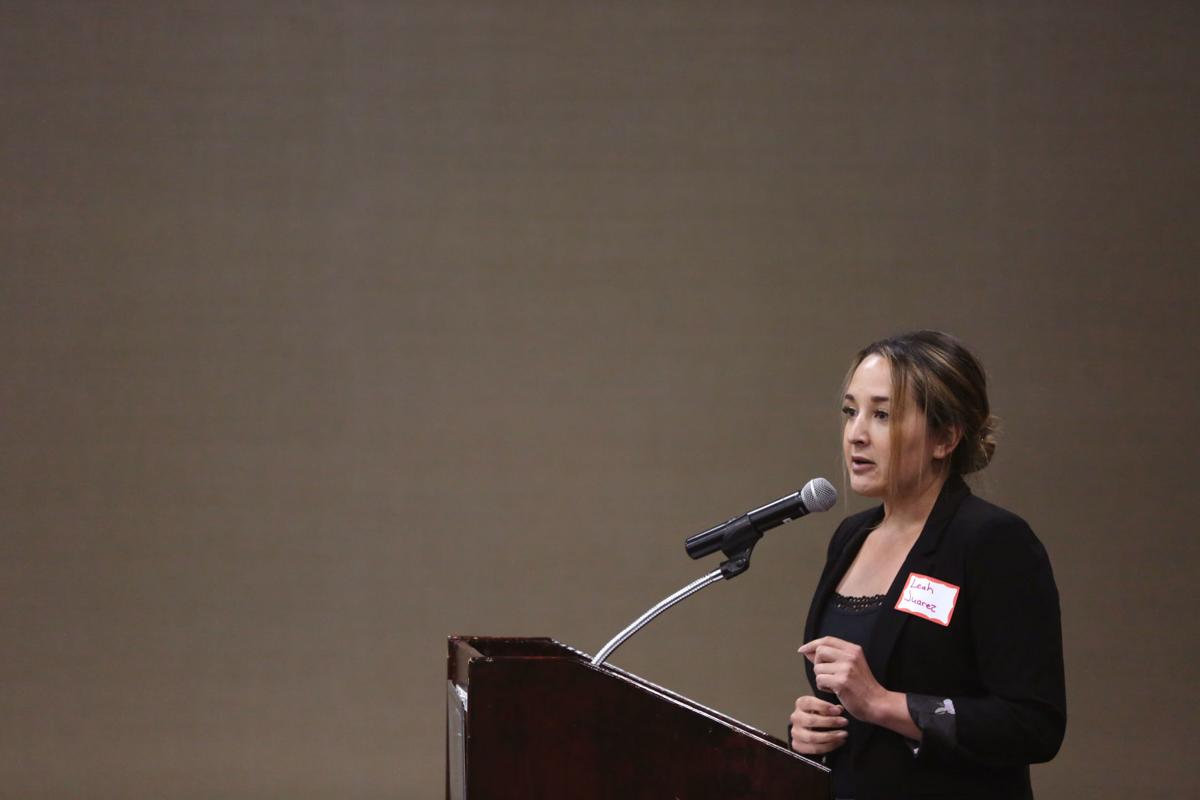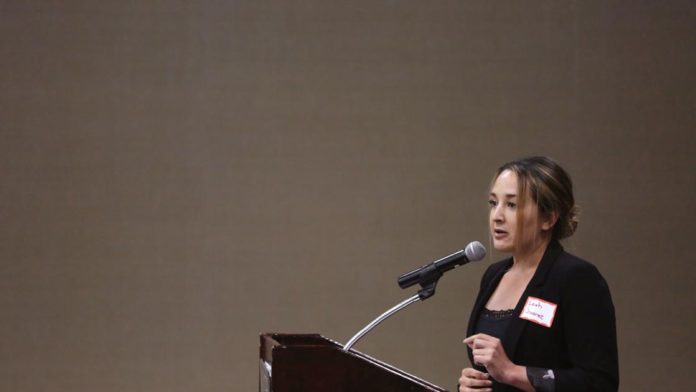
Legislative candidate Leah Juarez gives her closing speech at a forum in Casper hosted Wednesday by the Natrona County Republicans. A new group is working to get more Wyoming women elected to office.
Leah Juarez is many things.
She’s an accomplished entrepreneur, running several businesses in and around Casper. She’s a community advocate, helping a local movement to save Mills’ fire department last year after the mayor there threatened to defund it. She’s a proud Latina woman who’s happy to talk about what her community means to her.
Juarez is also a member of a demographic that has long been underrepresented in American politics: a Republican woman running for elected office.
Traditionally, government at almost every level — from state legislatures to U.S. Congress — has been dominated by men. In Wyoming, just 14 of the 90 lawmakers in the statehouse are women. And when women do seek office, they usually run as Democrats. In the 2018 midterms, Democratic women ran at a rate three times higher than their Republican counterparts, according to the Center for American Women in Politics.
It’s an acknowledged problem in state and national politics, enough so that U.S. Rep. Liz Cheney and the Republican Party have committed to efforts to boost female representation throughout the GOP through a mix of fundraisers, political events and candidate mentorship, according to Cheney spokesperson Jeremy Adler. It’s an issue that Juarez, a Mills resident and House District 59 candidate, has encountered herself.
On Wednesday, Juarez — speaking at a candidate forum in Casper — told audience members that someone on her campaign’s Facebook page called her a “traitor” for running as a Republican and, in their view, turning her back on her community and women’s issues because of her conservative beliefs.

Juarez, however, sees her campaign as emblematic of the need for women to have an equal say in all levels of public life, whether they consider themselves a Republican or Democrat.
“I think it’s important for people to understand that I can be a minority and I can be a woman and still have Republican values to the core,” she said in a Friday interview with the Star-Tribune. “I just think it’s so important for people to step up and not be intimidated by the political platform. Even if you’re running for city council, it shouldn’t be something that looks a specific way. It should encompass everybody and represent many different types of people.”
Declining representation
Wyoming has a proud history of women in politics. The birthplace of women’s suffrage, Wyoming notably appointed the nation’s first female justice of the peace, had the first town in the country to be governed entirely by women and elected America’s first female governor.
More recently, women held a number of key positions within the Wyoming Legislature in the 1980s and, within the past decade, both the House Minority and Majority Floor Leader positions within the Legislature were both occupied by women – a rare feat for a state body long dominated by men.
That legacy hasn’t been reflected in Wyoming recently, however, where the state’s “citizen legislature” bears little resemblance to the composition of the citizenry it serves. According to a Star-Tribune analysis last year, state lawmakers are typically older and much more affluent than the citizens of their districts, while men outnumber women by a rate of more than 5:1 despite women making up 49 percent of the state’s population.

Minority Floor Leader Cathy Connolly attends a session of the Wyoming Legislature in February. Although Wyoming has a proud history of women’s suffrage, it elects few women to state office.
“It basically sends a message right out of the gate that you don’t belong here,” said Jen Simons, the executive director of the nonpartisan Wyoming Women’s Action Network.
This, in turn, has had a profound effect on policy: Conversations on women’s issues and hot-button topics like child care access and abortion are dominated by men. Meanwhile, the Legislature’s most powerful committees – including the influential Joint Appropriations Committee – have zero female members even as they discuss issues impacting all Wyomingites.
“We’re in a budget crisis,” Simons added. “And when you turn on during appropriations, and there are 12 white men who are making those decisions. There is no way that can possibly accurately reflect the lived experience of a huge portion of our state.”
Working for change
Stories like Juarez’s are why Simons and other women around the state are working for change.
Earlier this year, Simons announced a partnership with several other women in Wyoming politics to form the Cowgirl Run Fund, a nonpartisan political action committee committed to increasing the number of women represented in Wyoming politics, regardless of their party affiliation.

The PAC — which officially launched last Friday with a bipartisan list of 29 candidates it was supporting – hopes to provide its candidates with the financial support and mentorship needed to overcome a number of the systemic disadvantages facing women running for office in Wyoming.
“Like with anything else, if there’s something you want to get involved in but don’t know anything about – like if I really want to start trail running or I really want to start fly fishing, but don’t know anything about it … if there was a group that said, ‘Come, we’ll show you how to do this,’ it makes it manageable,” JoAnn Skeim-True, a member of the Natrona County Republican Party’s executive committee and a co-founder of the fund, said in an interview. “It makes it a target that you can actually do.”
Simons hopes the group’s efforts help draw attention to the many barriers to public office that women face not just in the Equality State, but around the country. On Thursday, Simons – who also serves as a senior policy adviser with the Equality State Policy Center – hosted a forum featuring a number of key figures helping to elect more women in politics.
The panelists – which included Vote at Home Institute founder Amber McReynolds and RepresentWomen CEO Cynthia Richie Terrell – outlined a number of policy decisions that have impacted women’s ability to run for and hold office across the country, some of which could feasibly be implemented in Wyoming.

Sen. Affie Ellis looks up to the gallery in the Senate Chamber of the Capitol in February in Cheyenne. Women make up only 15% of state lawmakers in Wyoming.
One solution, recommended by Richie Terrell, could be the return of multi-member districts, which allows voters to select numerous people to represent them in the Legislature, which could encourage voters to choose from a diverse field of candidates. These districts – which were once prevalent in Wyoming before being ruled unconstitutional by a federal judge in 1991 – have been shown to increase the number of women holding elected office.
Other reforms, like ranked-choice voting, have been shown to substantially increase the amount of women elected in the cities that use it.
Then there’s the financial side of the conversation, where the gatekeepers in state and national politics – be it wealthy donors or political action committees – tend to focus their attention on incumbents, reinforcing the often male-dominant status quo. By introducing organizations focused on electing women, like the Cowgirl Run Fund, women of all ages and incomes can participate on a more even playing field with male candidates who already benefit from the advantages that help elevate them to power, be that personal wealth, familial expectations or other factors.
Searching for success
Ultimately, the change that matters won’t come until more women run for – and are elected to – public office.
So far, that hasn’t happened in Wyoming. However, it’s not for a lack of trying. This year, 39 women are running for the Wyoming Legislature, according to candidate filings with the Wyoming Secretary of State, slightly up from the 34 who ran in 2018 and the 36 who did in 2016. Ultimately getting past that barrier, Simons said, will take time, and making a conscious effort to get women engaged at all levels of leadership, from the city council to Cheyenne.
“We’re trying to make sure that there are women in the pipeline, and that they are running for things like the (Laramie County Community College) board,” said Simons. “We need them running for these nonpartisan local offices so that there are women who understand the process, who have gotten the experience of running the campaign at a hyper local level, and are really building that base of women and creating a broader group of people who can not only rely on each other, but can also start to feed all those higher levels of office, too.”
By not doing so, the state loses something valuable, Juarez said: the ability to legislate for all people, not just with good intentions, but with an innate understanding of what they need.
“We really have to understand that women have a perspective on the world that is unique and should be valued,” she said. “It’s not to say that men don’t have our best interests in mind. But you know, when we walk through motherhood in pregnancy, that’s just an experience that men unfortunately will never be able to understand. And so our views may differ slightly, but at the end of the day, we want the same goal. But you should be able to look at the House of Representatives and to see yourself there.
“I hope that I can be a representation for other minorities or other women to say, ‘Well, if she did it, I can do it,’” she added. “I want them to think ‘I can make a change, too.’”
Stay up-to-date on the latest in local and national government and political topics with our newsletter.
Credit: Source link































